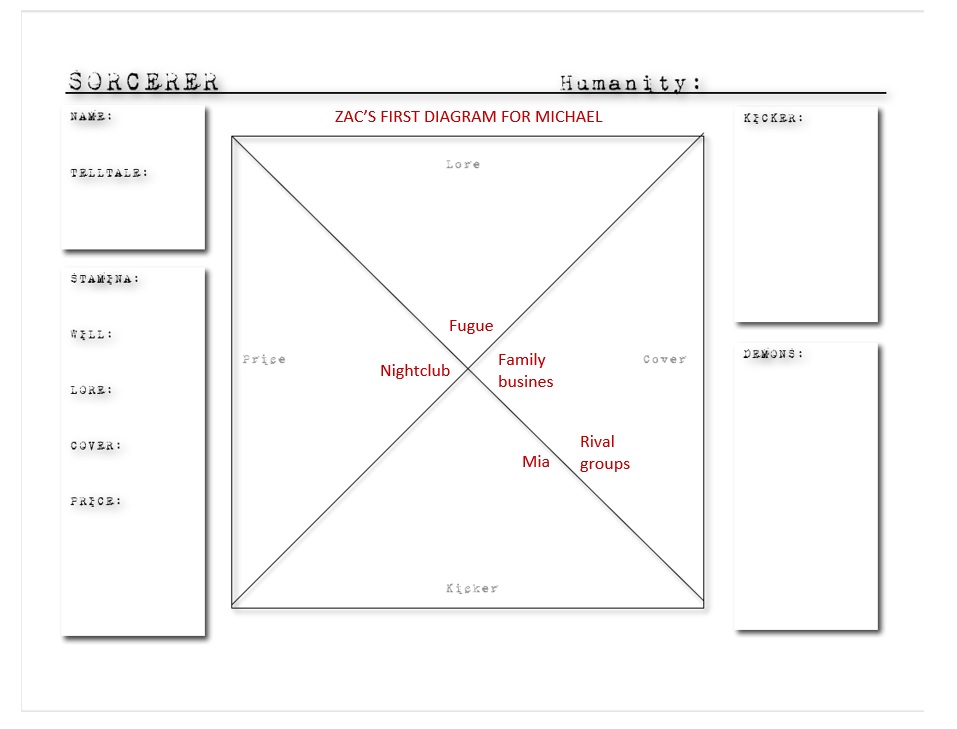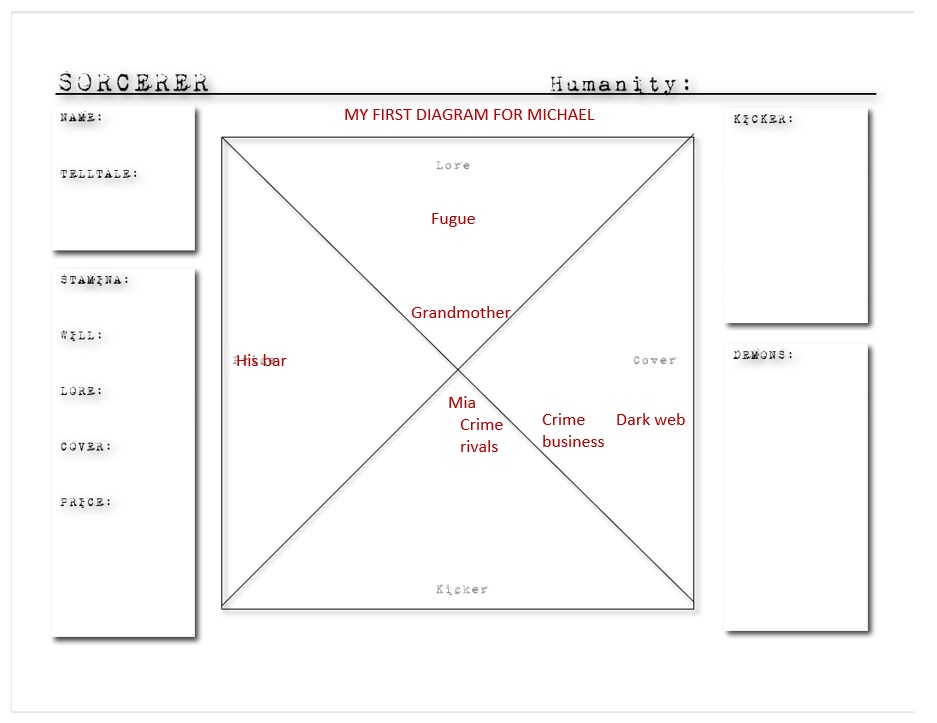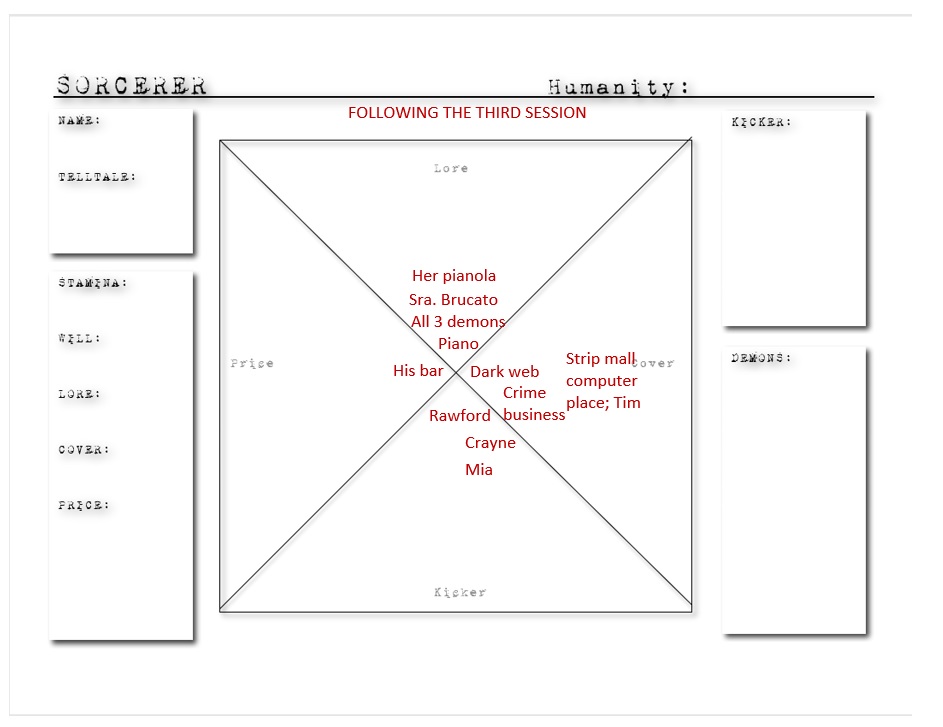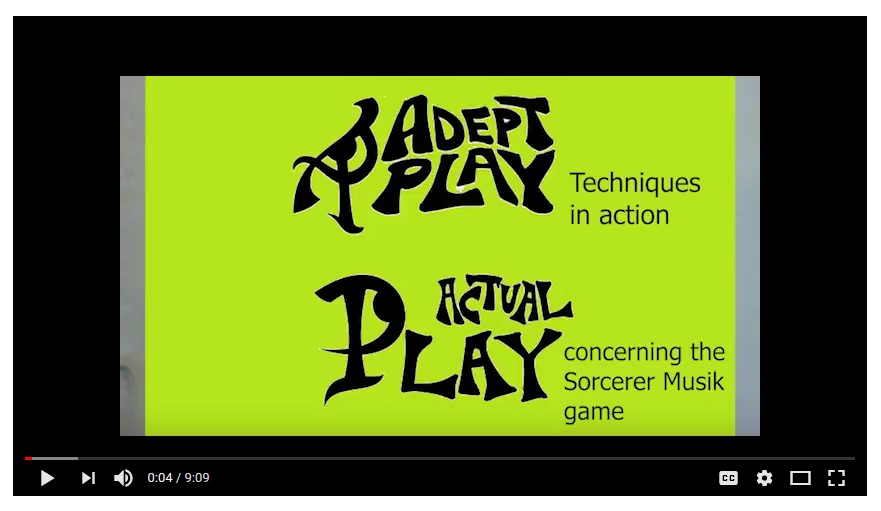Here’s a techniques discussion of the Sorcerer character diagrams, which is a spiky topic in the case of this game. I didn’t realize the physical separation among us would be this significant, and I’m worried enough to reflect here. First, a detailed look at how the damn things work:
Now let’s apply this to play, and to Sorcerer Musik especially, including the fourth session which is right here in the post too. When you watch the session, you’ll see a lot of good material, and a lot of good will among everyone, but you might spot some inequality among spotlight time, agency, and proactivity. I think I have a pretty good idea why.
Take a look at Michael’s initial diagram that Zac drew,

… and the one that I drew. They aren’t the same.

Neither, in retrospect, is really correct based on his starting material, and we brought them to play having barely glanced at them. Using mine, that’s why I put his first scene in the game at the hospital with his sister Mia, by themselves, but with his grandmother already interfering with his demon. If I’d used his diagram, the opening would have been at his bar and focused heavily on criminal leadership stuff.
Note, too, that his grandmother is not in his diagram – and I should have attended to that like a five-alarm fire, before play. His Lore descriptor is Apprentice, and she’s the mentor, period. It’s a central feature of his character and should be represented on the diagram with at least two, probably more items.
After each session, I kept re-doing the diagrams, but again, by myself and without the players seeing what’s going on. After the third, which included Michael’s demon Fugue becoming aware of the other sorcerers at Michael’s orders, Michael’s looked like this:

Why? Because the demons’ “music” is harmonizing, and that brought every sorcerer’s paraphernalia straight to the center of each diagram, dragging anything associated with it. (For example, in Alain’s diagram, John Landis was no longer at the center, just like Mia isn’t in this one.)
Maybe you’ve been watching and reading this without knowing what these things are for … that the center determines what the GM plays at the beginning of the session. That’s why I am always asking the players, over and over, broken record, where are you, what does it look like, what are you doing, if you’re done where are you going next. They frame their scenes based on what they think and want following the prior events; my job is to put in content based on what they say and also based on each diagram’s bull’s-eye.
So I began the session shown in this post with the above diagram in front of me. The interaction among the demons established in prior play, now that Fugue was in on it, at the center. According to Zac, Michael was being driven to the Skinned Cat. His diagram said, unequivocally, demons, which means for him, on the one hand, his suddenly deeply-invested grandmother (who thinks she’s his mentor/master no matter what he feels about it), and on the other, his piano as his primary sorcerous tool, which means his bar as well. Note that each of the other sorcerers is present in the diagram, but in his case, behind each demon.
You see the disconnect, right? It has several facets. In retrospect, to me, Zac had painted a vivid picture of the estrangement between Michael and Sra. Brucato, and of her specific interaction with their family, whereas it’s possible that to him, she was a “done with” feature of his character’s descriptor. He even asked things about her during play that I thought he had emphatically explained to me a few weeks ago. It’s possible that to him, I am playing my story now, and putting it on him, saddling him with this woman he doesn’t want to have in there.
[Clarification: Rawford’s in the middle of the diagram too. I had his next move ready to go, relating to the bar and Sra. Brucato; in fact, by the end of play, he’d already done it. But I’d fumbled the simultaneity of play to the extent that Michael’s events had received very little forward motion, and we simply didn’t get that far.]
Another facet concerns player agency and character action. Crucially: given my perception of the center of the diagram (even without the above disconnect), does that mean I force Michael into the bar? Does he have to meet his grandmother there? No. That would only occur if Zac told me Michael was at or going to the bar already, such that his grandmother shows up, or if, conceivably, he were with his grandmother, such that she reveals her knowledge of the bar and his piano there. Since this isn’t the case, I play this as Michael learning about her being there, in this case because the grandmother gets the bar guy to call him.
But I am not trying to make him go there. This is a call to Michael from his grandmother, not a call from the GM to Zac.
I’m positive this indicates a developing rupture in techniques-and-purpose. To clarify that, let me explain the important converse of “at the center,” in terms of play techniques.
What I mean is, what happens with the things that aren’t in the middle of the diagram? They’re not frozen. They’re doing things that aren’t my responsibility to tell the player. Crayne is certainly up to no good, and given what’s occurred already, is probably moving to threaten Michael’s professional interests and immediate family even more. I have notes for that; for example, Bobby Crayne is definitely doing something heinous, outside of Michael’s immediate sphere of perception. In GM terms, I make notes for what he’s doing and what consequences may necessarily become evident to Michael later, but I don’t have any of that come in upon Michael at this time.
However, should it have been the case that Zac said, “I’m going to deal with Crayne,” in any of a hundred possible ways to express that in aims and actions, I mean, considering this is the guy who personally assaulted and traumatized Mia, then that’s what we’d do. Since Michael already investigated the Burbank police successfully, and recently infiltrated them, he’d come upon Crayne, and various assets or associations of theirs engaged in exactly those acts, or whatever else might make sense for them to be doing given the hour of day or night in the fiction.
But – Zac didn’t know any of this, and although I can’t speak for him, I’m sensitive to what’s occurred in a couple past cases – when a player is not picking up the dynamics intuitively, partly because I didn’t start out using them properly and partly due to our physical separation. They’re not seeing any of the instruments of play, including the results of my rolls, so it’s easy to think I’m making the situations and outcomes up. What I do looks like the same old GMing, and they start to think in terms of planned events and programmed sessions, as opposed to proactivity that’s completely under their control regardless of what information or communications come along.
GM and player internal experiences, respectively, aren’t the same in Sorcerer, but there still shouldn’t be a screen up regarding what they do, procedurally. The medium is unexpectedly imposing enough of a screen that it might have caused a problem.


11 responses to “Sorcerer Musik – harmony and dissonance”
A Little Bit of Murk Leavens the Whole Loaf
Hi all, this is an
I'm actually thrilled that we've caught this instantiation of murk, since it gives us a chance to work out a real problem that's occurred. Untying knots together deepens the group dynamic. I've seen less than this make a game deteriorate into the weekly "friendship chore".
Like Pedro, during character creation, I had only a vague snapshot of Maxine's character and who she might become during the course of play. I've ended up playing her with a naive, almost gullable personality with a vain temperment, which isn't how I originally envisioned her, but it's been really fun to let her evolve this way. It seemed right to me to allow her obsession with the music drive her into this stereotype. So, also like Pedro, I didn't run feeling like I needed to fight for my vision of my character. In a way, I don't view her conception as strictly my intellectual property. Who Max is now is a starting point for me to grow her in the context of our story — but that isn't to say that I have some ideas about where I want to take her character. I haven't felt railroaded — only guided.
I have to echo Pedro here when I say how much I've been enjoying playing Sorcerer so far. Generally speaking, I think it's super fascinating that Sorcerer is so sensitive to interpersonal dynamics. We've had a little murk enter here, and if we hadn't talked about it, the value we are getting out of the game could trend downward. I mean, that's a generally true social principle that you can experience in any shared activity — anywhere from the workplace, to a marriage, to a game of Monopoly — but it seems to me that Sorcerer is so intensely focused on shared momentum, enthusiasm, and creativity that the need for harmony and understanding is unusually cricital.
Whew! Our recent session
Whew! Our recent session following this one speaks for itself, so a lot of what I'd planned for a reply here can be left for its posting (soon). What's left is maybe more argumentative sounding than it is, in that context.
I don't think our play is fragile, or that coherent play of this kind is fragile. I think it's vulnerable to messing up the rules much in the way a standard card game is. That's different from the vulnerability of a card game in action to breakdown of function and enjoyment, as a feature of its experience. Such a card game is simply badly designed – like, bluntly, a significant swath of historical role-playing, notwithstanding many historical points of brilliance. Another way to put it is that we don't see many if any such traditional card games because at the folk level, no one would play them.
The good news is that mesing up the rules of a good game, and correcting that, is an acceptable part of a learning curve. To shift to professor and college mode for a second, I even think that a course where nothing like that happens is overly tame and needs redesign so that one can see more hiccups and re-dos as part of the history of each term's experience.
But this isn't a course, it's a fun group leisure activity, so that can't be held as an ideal. In this case I think that the online medium is really hard on Sorcerer, and the missed/botched rules are my fault for not realizing how. But I don't think it's the oh-no, disaster, this is failing circumstance which I'm afraid our hobby has made of it. Learning curves are a good thing, is my position. Embracing them, and their features, is one of those hobby cultural difficulties that could stand some light shined on it.
So back to the fragility. As far as I can tell, identifying and restoring the rules that weren't being applied is working just the same as it would for a card game – the exact opposite of repairing and laboriously holding-up crap rules through constant social smoothing. The rules in particular concerned the necessary player knowledge – e.g., if a sorcerer knows anything at the outset of play, it's his or her demon's Need, and the full I-said-it-you-know-it about all the descriptors. The play instruments in particular concerned the diagrams, full stop.
The play experience is really important here, in that the players actually see the GM rolling dice, not only for the values, but also to establish, not even verbalizing it, that he or she is not makin' up stuff on the fly for whatever it is a demon or other character does next.
That's a big deal in terms of a couple other points, which at this time are mere claims but may evolve as we continue. For instance, I'm not even a guide. All I do is cross, i.e., have characters' actions affect the backgrounds and potential perceptions of the other characters, and weave, which in this case means elaborating upon the interaction of the demons as expressions of music. And in that context, I play all the demons and NPCs both proactively and responsively. That's it!
Jann, I suggest that what feels like guiding is more internal and proactive on your part than it feels like, much as any artist says, rightly, that they feel guided when they produce or perform in particularly effective and what others call "inspired" ways.
My only other comment concerns the bread-loaf metaphor, in that leavening is a good thing, so I'd probably reference rat turds for the "pinch of" analogy. But the immediate meaning is the same, so yes. Murk is a bad thing; there's no way to say, OK, just a little, we can live with it and get through it. You can get through it but you will have been and will continue to be eating … um, yeah.
Session 5, with accompaniment
We had a really nice session after that, composed of a workshop on the diagrams and other conceptual same-page topics, with only about fifteen minutes of play at the end – but oh, such substantial play. The characters are so who they are.
Sorcerer Musik 5
I can tell Sorcerer is working for me when I start getting personally weird about the fictional metaphysics, and looking up stuff like this:
That lack of shared physical space, especially pertaining to objects, still led me to stumble at one point, when I asked what item pulled Zac's demon to the center of the sheet, and he answered "the other demons" – which isn't right, as all of the demons are placed in his Lore sector. The association that pulls them there is the three-way of his demon, his crime business, and his criminal rival Rawford. That's where I should have set him at the outset, or rather, with perceptions and information pertaining to that particular combination. The three demons' musical interaction was happening anyway and would have intruded, and things might have gone the same, but it wouldn't have started with those perceptions first.
Diagram delights
So, after our Sorcerer game Greg, Robbie and I had a discussion about using the diagrams and Greg helpfully gave me a list of references from Adept Play to check out. Among them, I'm singling out this post as number one with a bullet for any new or journeyman Sorcerer GM to read — both for the explanation of the diagrams in the initial post, and for the assurance that a learning curve is not a failure state later in the comments.
Incidentally, most or all of the links Greg gave me were things I'd read or watched before, upon their appearance at the site. In retrospect, it would have been wise to track them down myself and review them immediately before starting the diagram process for my game.
I’m back here again having re
I'm back here again having re-watched the video after Greg's game and the many diagram discussions we had. I have a specific question having to do with the case of "Mark's fancy house" that starts around 4:44. The fancy house is attracted to Mark, who is in the center, but is not itself in the center. That being the case, if I am the GM here, what obligation if any do I have towards the fancy house in framing the first scene of the session?
(In my comment above I’m
(In my comment above I'm referring to the "Sorcerer Diagramming Technique" in the body of the first paragraph, not the gameplay video)
Hi Rod! I might go a little
Hi Rod! I might go a little bit slowly. Also, I regard this conversation as first attempts compared to a couple of the later posts, so I'm not very invested in some of the phrasing or exact chain of argument. Some of it turned out to be misleading or at least didn't help anyone at the time.
I need to check in with one thing about your question. It might be a simple clarification for me about what you mean, or it might be a big issue which basically negates the question, but I can't tell which.
Here's the thing which I'm pretty sure you get without need for explanation, but it's never bad to reinforce it for anyone who's reading: Mark isn't "in the center" in any intrinsic-to-Mark way. He's only in the center with the wrench and photo because they are attached ("attracted," whatever) across the center as well as to him. The idea is that Mark is also attached to the house within the Cover sector, so it comes with him, and is positioned in the diagram as kind of a tail on his kite.
Now for the hard part: the obligation. Are we to think that Mark is always, always in the house? That it's so attached to him, diagram-wise, that we can't see him at the start of a session unless he's in it, or at least on the porch? That if he were in prison at the end of a session, that the start of the next would either teleport him from his cell to his house across town, or vice versa so now his house is crammed into his cell with him?
Hopefully I'm giving away the answer, that no, our GM is not obliged to do anything outright stupid. But what is the benchmark for that? I think it's pretty easy, fortunately. Keeping in mind that the house is not attached to anything across the zones and therefore cannot be at the center, then its presence on the diagram operates only – but unavoidably! – to raise the question, and to demand an answer for it, regarding where and how we left off last time for both Mark and the house.
Was he bound and gagged in the cellar? Then the house is here. Was he, as suggested above, in a prison cell? Then it isn't. Have the events of play left it unknown? Then by definition, the GM decides. Given the diagram as we're looking at it at that point in the video, Mark might be in the house or not in the house, so the house might be in the first scene, or it might not.
[Side note for anyone who needs it: don't call that "fiat." If it is a job that must be done and there is no other way to do it, i.e., it doesn't override someone else's job or some known procedure, then it's not fiat at all. Calling such things fiat is an artifact of the toxic legacy of perceiving "GM says" as being over-and-above play, capable of overriding anything else. In the non-toxic context, and in the precise fictional and diagrammatic circumstances I've described, "GM says" whether the house is in the first scene is no different from "you saying" your character walks across the room and mixes a White Russian with non-dairy creamer.]
It's less arbitrary than it sounds. After even a single session of play, Mark probably wants something or is otherwise active in some way. Therefore if events have left his whereabouts unknown, or at least not as deterministically fixed in place as my two options above, then the GM may consult his or her own sense of what Mark has troubled himself to do, and we can begin play with wherever that has taken him, and that may be located in the house or not in the house depending on what it is.
Let me know if that makes any sense.
Yes, that makes sense. So, to
Yes, that makes sense. So, to check my understanding: Mark is in the center (with the wrench and the other thingy) so his inclusion in the first scene in some way is required. The house, as a dependent of Mark (so to speak), is considered for inclusion but shouldn't be forced if it doesn't make sense. Is this correct?
“Just det” (Swedish), meaning
"Just det" (Swedish), meaning, yes, exactly that. Pronounced, to the native-English ear, "yoosta."